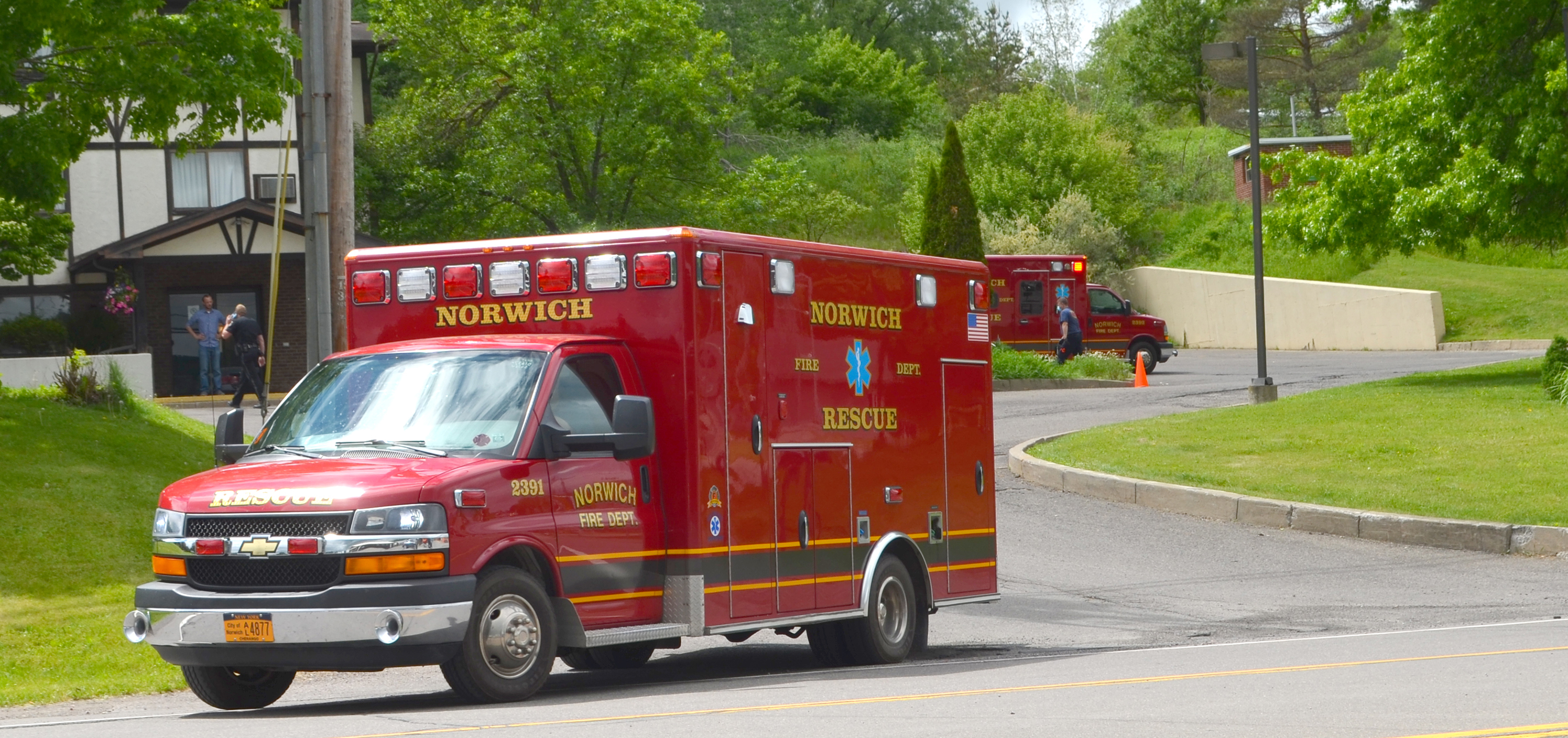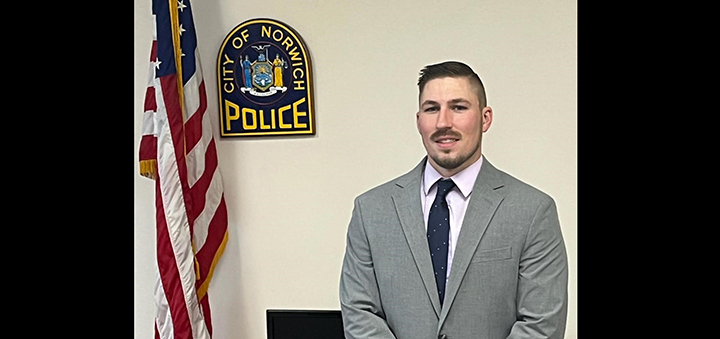“On The Brink Of Death”— Breaking Down Chenango County’s Overdose Crisis
Published:
June 23rd, 2023
By:
Lilli Iannella
 Norwich Emergency Medical Services and the Chenango County Sheriff's Office respond to a reported fatal overdose at a local hotel in June 2022. (Photo by Tyler Murphy)
Norwich Emergency Medical Services and the Chenango County Sheriff's Office respond to a reported fatal overdose at a local hotel in June 2022. (Photo by Tyler Murphy)
Editor’s note: This story contains details of addiction and overdoses. If you are struggling with addiction contact the Substance Abuse and Mental Health Services Administration hotline by calling 1-800-662-4357 or by going to https://www.samhsa.gov/find-help/national-helpline
CHENANGO COUNTY – While an arrested man sat handcuffed to a chair in the Norwich Police Department, Chief Reuben Roach and surrounding officers watched as drool dripped down his face.
His shallow breaths, gray-blue skin and lowered head alerted the officers to act fast– these were symptoms of an overdose, Roach said, and they needed to apply Narcan, also known as naloxone, a nasal spray that would reverse his effects.
Just as officers were about to use Narcan, the man kicked, punched and fought, and he covered his nose so that they couldn’t give it to him.
“He’s on the brink of death, and he knows it. We’re telling him– you’re going to die, you look like you’re going to die if you don’t get Narcan,” Roach said. “He did not want to lose his high.”
The man fought the officers the whole way, right up until they brought him to the hospital, where Roach said doctors strapped him into a gurney to administer Narcan in hopes of saving him.
But this was just another day for Roach. He said officers use Narcan multiple times a week on those who overdose, sometimes using more than one dose on the same person, and they run out of it frequently. Even after applying the spray, some people don’t make it out alive, he said.
Opioid overdose deaths have increased in Chenango County since 2003, according to the most recent data from the New York State Department of Health (NYSDOH), which Public Information Officer Danielle DeSouza said is preliminary and subject to change as additional information is reported by state and local sources.
The county saw around 11 opioid overdose deaths in 2020, almost three times the amount in 2019. Eight of those deaths involved opioid pain relievers, including fentanyl.
Roach said he has noticed a trend of people buying fentanyl rather than heroin, since it is a stronger drug. Fentanyl is up to 50 times stronger than heroin, as explained by the Centers for Disease Control and Prevention (CDC).
Within the last five years, Roach said most overdose cases in Norwich and across Chenango County have involved methamphetamine (meth) or heroin contaminated with fentanyl. Public Health Director Isaiah Sutton said he has seen fatal overdose incidents arise in intermittent clusters, where events occur in groups rather than individual frequent cases.
In February 2022, Norwich Police tracked four suspected cocaine or heroin overdoses over the span of a few days, The Evening Sun reported. In April, six overdoses within a 24-hour period left two people dead, and officials suspected the overdoses to have involved heroin laced with fentanyl.
Roach said since December he has seen around seven overdose deaths in Norwich and thinks the community is on track to see double by the end of the year. This means numbers county-wide would be even higher, he said.
But this doesn’t reflect the nonfatal overdose cases Roach and other emergency personnel, as well as prevention programs, face on a weekly basis.
In New York state, and specifically Chenango County, the opioid overdose death toll would likely be higher without the use of Narcan, Sutton said.
In areas dominated by the use of fentanyl, like New York state, there is a higher need for Narcan than in areas characterized by heroin or prescription opioid use, according to a 2022 study published in The Lancet. Overdoses involving large quantities of opioids or more potent substances like fentanyl can require additional doses of Narcan, as indicated in the Substance Abuse and Mental Health Service Administration’s Overdose Prevention Toolkit.
Across the state, Chenango County had the highest rate of Narcan usage by emergency medical services in 2021.
The county’s rate was over two times that of the New York state average, amounting to almost 10 per 1,000 people, and Norwich accounted for almost half of its use. Sutton said this increase is in part due to the availability of Narcan and the adoption of its use by local first response agencies.
“Those groups should be commended for the amazing work they’ve done,” he said. “And I think the number of opioid deaths in our community would be threefold without them utilizing this medication.”
The study by The Lancet also said that Narcan prevented more overdose deaths when it was distributed by community organizations and pharmacy-initiated programs.
According to NYSDOH county opioid quarterly reports, in 2021 and 2022, Community Opioid Overdose Prevention (COOP) programs used more Narcan than emergency medical services and police officers. Sutton called this a “divergence from traditional policing,” as Narcan is being more extensively dispensed from prevention programs rather than emergency officials.
Last month, Sutton said The Chenango County Health Department held a Narcan training session for industry workers. The Friends of Recovery of Delaware and Otsego Counties (FORDO) also provide weekly Narcan training for its five service locations, including The Turning Point in Norwich, said Kyle LaFever, the Peer Services Coordinator at FORDO. In June, The Turning Point installed a Narcan vending machine located inside of its site, LaFever said.
April Carney, who works with The Turning Point, said people may have loaded up on Narcan because they didn’t know how to treat xylazine overdoses. Xylazine is an animal tranquilizer, and since it is not an opioid, Narcan does not reverse its effects, according to the United States Drug Enforcement Administration. Carney said the increase of overdoses involving both xylazine and fentanyl may have accounted for the increase in Narcan use outside of emergency officials.
Out of the 30 towns, villages and cities in Chenango County, in 2020, Norwich had the highest “opioid burden” with 27 people. In order to define the measure, the NYSDOH combines several data points, like opioid overdose deaths, nonfatal outpatient emergency department visits and hospital discharges related to opioid overdose, abuse and dependence.
Chenango County is one of five counties in New York state’s Southern Tier, according to the NYSDOH dataset. In 2020, the only other cities in the Southern Tier that had higher opioid burden rates than Norwich were Ithaca and the “Triple Cities” that form the Binghamton Metropolitan area– Binghamton, Endicott and Johnson City. While Norwich had a population of just under 7,000 people in 2020, Endicott held the smallest population at about 13,500 people, and Binghamton had the largest total at around 47,000 people.
When responding to overdose incidents, Roach said that many people are violent and combative, like the man who refused Narcan, while others may become paranoid. He recalled an instance where a woman, who was a meth user, believed she carried Jesus Christ in a shoebox. Some may even commit assault, he said, recalling an instance where a man tied up his girlfriend and beat her with a stake for three days because he thought she was running a brothel.
“I mean, it didn’t make any sense,” Roach said. “Methamphetamine and heroin– it doesn’t matter who you are or what your ethnicity or gender is, it cares less, it’ll destroy your life across the board.”
The number of New York state residents admitted to treatment programs also indicates the opioid burden is high, the NYSDOH said in their 2019 Opioid Annual Report. Although admissions to substance use disorder programs for all opioids including heroin were not high in 2021, Norwich accounted for over half the admissions in the county with 140. The second-highest admission count, in Sherburne, was 23.
Specifically for the use of heroin alone, there were 104 admissions in 2021, representing about 75% of total admissions in Norwich.
Sutton said his department tracks secondary risks like hepatitis C, a liver disease that can be contracted from drug injection, and he noticed an increase in drug use due to an increase in hepatitis C cases. In 2021, a three-county region consisting of Broome, Chenango and Tioga had 171 new cases, amounting to the highest number of cases per 100,000 people than any other region in New York state, according to the NYSDOH.
While cleaning drug paraphernalia, including syringes, littered in Norwich public parks alongside her husband, Carney said she promotes The Turning Point to those who she thinks may need recovery services and tells them where to get Narcan. Carney said she is five years in recovery and stayed clean through the loss of her 16-year-old daughter to suicide two years ago. She said it is part of her recovery to help other people.
“I'd say since the last year that we've been doing this, about 50 to 60% of the people do show up in these meetings,” she said. “As much as people complain in this area about the addiction and the people addicted, all they offer is judgment– they don't offer solutions, and it's not really their fault that they're kind of ignorant to what's available.”
Chenango County currently has four substance use disorder agencies providing different inpatient and outpatient services. Carney moved to Norwich a year ago, and she said the services near her previous Pennsylvania residence seemed to be more widely promoted than they are in Norwich, which aggravates the cycle of addiction.
“I feel like because people don't have recovery readily available all the time, that leads people to their own devices and ultimately using more drugs,” she said.
More urban areas like Onondaga and Cayuga counties have their own overdose data dashboards. Sutton said with cases being more intermittent and limited resources, a real-time system wouldn’t be able to run in Chenango County.
“We just really don’t have the resources to set that up,” he said. “And I also think our occurrences probably wouldn’t be enough to keep a program like that busy locally.”
Roach and Elizabeth Warneck, along with New York state Comptroller Thomas P. DiNapoli, said the consequences of COVID-19, like isolation, are possible factors that led to an increase in overdoses. But Warneck, the director of the Chenango County Behavioral Health Services, said it is difficult to claim a certain reason as to why occurrences have increased.
“It is hard to say the exact cause, but certainly the pandemic increased isolation and decreased the number of formal and natural supports that individuals have had access to,” Warneck said.
For those suffering with addiction, Sutton encouraged individuals to utilize the resources in the community, like FORDO and the Chenango County Behavioral Health Services.
“Often that first step does need to be taken by the individual or the individual encounter with family and friends and the folks around them to help build a safe structure,” he said. “And there are definitely resources in our community looking to help with that…If folks get discouraged, I would say don't give up. Keep trying and never stop trying to make healthy choices.”
Author: Lilli Iannella - More From This Author
Comments





